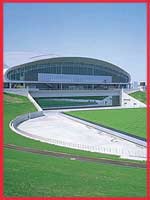 365 Feature
SAPPORO DOME: A PITCH THAT MOVES
29/05/02
by Jeff Dieffenbach
This article is the first in a series of occasional pieces on noteworthy fields and stadiums.
In June of 1994, the Pontiac Silverdome in Michigan hosted four men’s World Cup matches. The games marked the first World Cup contests played indoors. Perhaps more notably, grass stain, and not turf burn, ruled the day.
For those four games plus an exhibition in 1993, stadium crews transformed the Silverdome, installing nearly 2,000 natural grass containing trays, most weighing nearly 3,000 pounds. [1]
In June of 2002, the Japanese city of Hitsujigaoka, just outside of Sapporo and home to the Sapporo Dome, promises to do the Silverdome “one” better. “One,” as in one tray of natural grass. All 8,300 tons of it.
The Sapporo Dome represents impressive technology (more on that to follow), but the ground was laid, quite literally, in Michigan in 1993.
First, why grass? FIFA’s Laws of the Game, last updated in 2001, make no mention of the word “grass” [2]. In fact, FIFA favors “the installation and use of artificial turf in climates and stadium microclimates where the maintenance and growth of natural grass is difficult.”
Until recently, however, artificial turf changed the game too dramatically. That all changed in 2001, when seven FIFA-approved facilities made their debut (two in France, one each in Canada, Germany, the Netherlands, Switzerland, and the United States).
In 1993, this technology was still years away, so grass it was. Grass could be grown indoors, to be sure, but not of a quality to withstand even a youth soccer match. Grass had first been tried indoors at the Houston Astrodome in 1965 [3]. The semitransparent roof caused problems for the players, however. Painting the roof killed the grass, and the 1966 season opened on Astroturf.
Michigan approached the problem differently, starting and wintering the grass in California before shipping it cross-country by truck. The team placed the sod in hexagonal, triangular, and trapezoidal shaped trays (1,850, 100, and 44 in number, respectively), staging the trays in the stadium parking lot before expending more than 1,000 person-hours to install them indoors. By all accounts, the surface performed admirably.
Asked in an interview at the time whether the expense of using the system repeatedly would be prohibitive, project lead John N. “Trey” Rogers, assistant professor of crop and soil sciences at the University of Michigan, replied, “It might be. The better use would be for a single-purpose stadium where the system could be permanently installed. That's why I think the Europeans, or the Japanese because of their new professional soccer league, might be the first people to embrace the concept of growing grass indoors.”
Fast forward eight years to the 42,831 seat Sapporo Dome. Rather than grow the grass indoors, architect Hiroshi Hara and Kawasaki Heavy Systems opted for a $412 million grow outdoors, slide indoors approach [4]. (By comparison, the New England Revolution’s new home, CMGI Field, totaled $325 million for 68,000 seats.)
When the Sapporo Dome soccer pitch is outdoors, artificial turf lines the dome floor for baseball use. To convert to soccer, crews roll up the turf in preparation. A wall then opens up and two sections of centerfield seating slide out of the way in opposite directions. At a speed of 13 feet per minute, a combination of wheels, magnetic guidance, and air pressure moves the tray endline-first through the opening.
As the tray enters, seating that lined the first and third base lines rotates about 45 degrees to align with the soccer touchlines. When the field is fully inside, it and the sideline seating rotate 90 degrees for best viewing. Finally, the two centerfield seating sections close together along with the exterior wall. (Click here to see an animation of the conversion.)
Total elapsed time? 5 hours, compared to 30-40 for the Silverdome.
And what of the quality of the pitch?
On June 1 at about 10:30pm local time, Germany and Saudi Arabia will exit the pitch following their opening match and let us all know.
|

